《经济学原理·曼昆·第三版》第25章
- 格式:ppt
- 大小:4.74 MB
- 文档页数:45
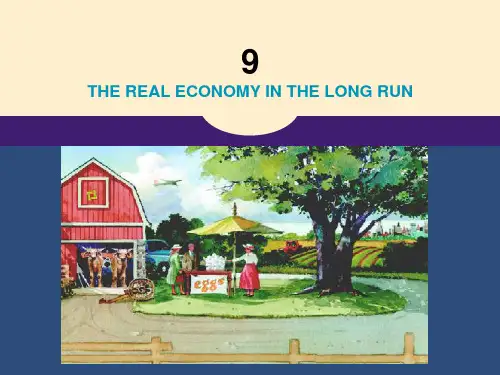
![曼昆经济学原理宏观第25章资料[文字可编辑]](https://uimg.taocdn.com/bebf290ebceb19e8b8f6baf4.webp)

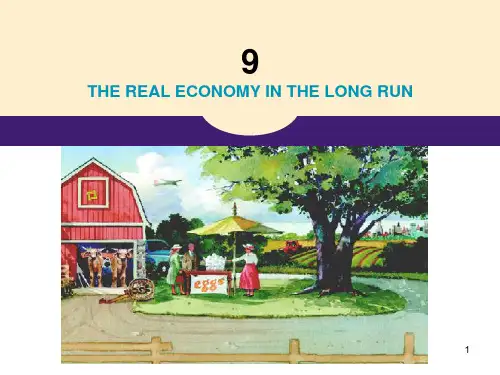
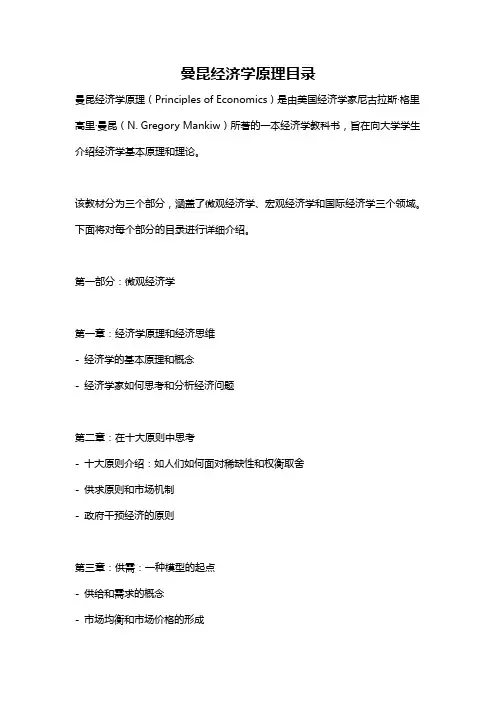
曼昆经济学原理目录曼昆经济学原理(Principles of Economics)是由美国经济学家尼古拉斯·格里高里·曼昆(N. Gregory Mankiw)所著的一本经济学教科书,旨在向大学学生介绍经济学基本原理和理论。
该教材分为三个部分,涵盖了微观经济学、宏观经济学和国际经济学三个领域。
下面将对每个部分的目录进行详细介绍。
第一部分:微观经济学第一章:经济学原理和经济思维- 经济学的基本原理和概念- 经济学家如何思考和分析经济问题第二章:在十大原则中思考- 十大原则介绍:如人们如何面对稀缺性和权衡取舍- 供求原则和市场机制- 政府干预经济的原则第三章:供需:一种模型的起点- 供给和需求的概念- 市场均衡和市场价格的形成- 自由市场与政府管制的比较第四章:市场效果:量与质的考虑- 市场效率和福利经济学- 市场失灵和外部性- 公共物品和共享资源第五章:务实的消费者和无穷的厂商- 消费者选择行为和效用最大化- 企业产量选择和生产成本- 供给曲线和市场调整第六章:市场均衡和资源配置- 市场均衡的概念和效率性- 供求关系和经济的资源配置- 政府政策和市场效率的影响第二部分:宏观经济学第七章:储蓄、投资和资本市场- 储蓄、投资和财务体系- 成本效益分析和资本市场的理论第八章:经济增长和生产函数- 国民收入和生产函数的概念- 技术进步和经济增长- 资本积累对经济增长的影响第九章:失业和通货膨胀- 失业和就业水平- 失业的成因和传统观点- 通货膨胀和货币政策第十章:货币和银行体系- 货币和货币供给- 银行体系和货币创造- 中央银行政策和货币政策工具第十一章:货币市场和货币政策- 资本市场和货币市场的联系- 货币市场利率和货币政策的影响- 货币供给和货币创造的影响第三部分:国际经济学第十二章:国际贸易的原理和比较优势- 国际贸易的原理和概念- 绝对优势和比较优势- 贸易制度和贸易政策第十三章:国际贸易的应用和政策- 暂定均衡和相对比较优势- 贸易政策和进出口管制- 贸易摩擦和贸易战争第十四章:国际金融与公共金融- 汇率和外汇市场- 货币政策和国际金融体系- 公共债务和国际金融危机曼昆经济学原理目录总共包括了14个章节,它们涵盖了经济学的基本原理和概念,并且深入探讨了微观经济学、宏观经济学和国际经济学的各个领域。
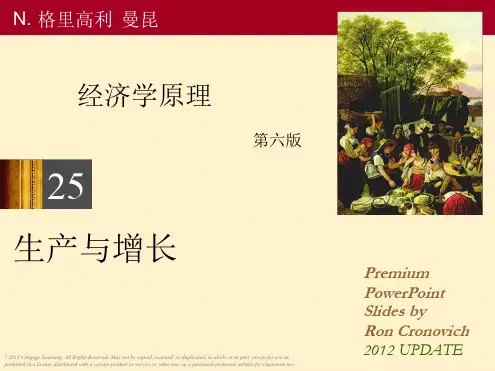
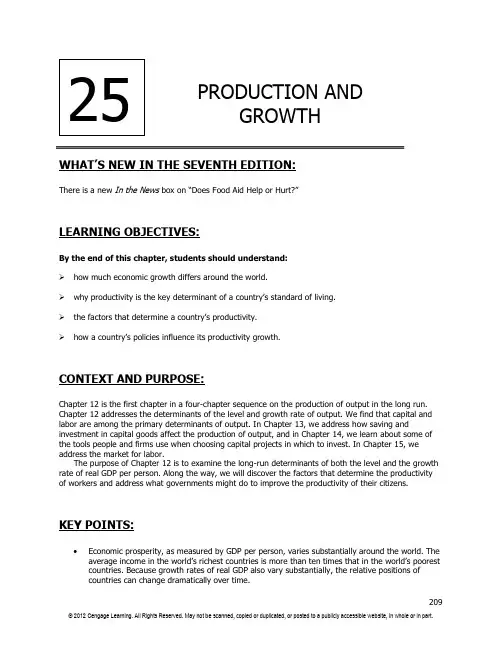
209WHAT’S NEW IN THE S EVENTH EDITION: There is a new In the News box on “Does Food Aid Help or Hurt?”LEARNING OBJECTIVES: By the end of this chapter, students should understand:how much economic growth differs around the world.why productivity is the key determinant of a country’s standard of living.the factors that determine a country’s productivity.how a country’s policies influence its productivity growth.CONTEXT AND PURPOSE: Chapter 12 is the first chapter in a four-chapter sequence on the production of output in the long run. Chapter 12 addresses the determinants of the level and growth rate of output. We find that capital and labor are among the primary determinants of output. In Chapter 13, we address how saving and investment in capital goods affect the production of output, and in Chapter 14, we learn about some of the tools people and firms use when choosing capital projects in which to invest. In Chapter 15, we address the market for labor.The purpose of Chapter 12 is to examine the long-run determinants of both the level and the growth rate of real GDP per person. Along the way, we will discover the factors that determine the productivity of workers and address what governments might do to improve the productivity of their citizens.KEY POINTS:Economic prosperity, as measured by GDP per person, varies substantially around the world. Theaverage income in the world’s richest countries is more than ten times that in the world’s poorest countries. Because growth rates of real GDP also vary substantially, the relative positions of countries can change dramatically over time.PRODUCTION AND GROWTH210 ❖Chapter 12/Production and Growth∙ The standard of living in an economy depends on the economy’s ability to produce goods and services. Productivity, in turn, depends on the amounts of physical capital, human capital, natural resources, and technological knowledge available to workers.∙ Government policies can try to influence the economy’s growth rate in many ways: by encouraging saving and investment, encouraging investment from abroad, fostering education, promoting good health, maintaining property rights and political stability, allowing free trade, and promoting the research and development of new technologies.∙ The accumulation of capital is subject to diminishing returns: The more capital an economy has, the less additional output the economy gets from an extra unit of capital. As a result, whilehigher saving leads to higher growth for a period of time, growth eventually slows down ascapital, productivity, and income rise. Also because of diminishing returns, the return to capital is especially high in poor countries. Other things equal, these countries can grow faster because of the catch-up effect.∙ Population growth has a variety of effects on economic growth. On the one hand, more rapid population growth may lower productivity by stretching the supply of natural resources and byreducing the amount of capital available for each worker. On the other hand, a larger population may enhance the rate of technological progress because there are more scientists and engineers.CHAPTER OUTLINE:I. Economic Growth around the WorldA. Table 1 shows data on real GDP per person for 13 countries during different periods of time.1. The data reveal the fact that living standards vary a great deal between these countries.2. Growth rates are also reported in the table. Japan has had the largest growth rate over time,2.65% per year (on average).3. Because of different growth rates, the ranking of countries by income per person changesover time.a. In the late 19th century, the United Kingdom was the richest country in the world.b. Today, income per person is lower in the United Kingdom than in the United States (aformer colony of the United Kingdom).Chapter 12/Production and Growth ❖211B. FYI: Are You Richer Than the Richest American?1. According to the magazine American Heritage, the richest American of all time is John B.Rockefeller, whose wealth today would be the equivalent of approximately $200 billion.2. Yet, because Rockefeller lived from 1839 to 1937, he did not get the chance to enjoy manyof the conveniences we take for granted today such as television, air conditioning, andmodern medicine.3. Thus, because of tech nological advances, the average American today may enjoy a “richer”life than the richest American who lived a century ago.C. FYI: A Picture Is Worth a Thousand Statistics1. This box presents three photos showing a typical family in three countries – the UnitedKingdom, Mexico, and Mali. Each family was photographed outside their home, together withall of their material possessions.2. These photos demonstrate the vast difference in the standards of living in these countries. II. Productivity: Its Role and DeterminantsA. Why Productivity Is So Important1. Example: Robinson Crusoea. Because he is stranded alone, he must catch his own fish, grow his own vegetables, andmake his own clothes.b. His standard of living depends on his ability to produce goods and services.2. Definition of productivity: the quantity of goods and services produced from eachunit of labor input.3. Review of Principle #8: A Country’s Standard of Living Depends on Its Ability to ProduceGoods and Services.B. How Productivity Is Determined1. Physical Capital per Workera. Definition of physical capital: the stock of equipment and structures used toproduce goods and services.b. Example: Crusoe will catch more fish if he has more fishing poles.2. Human Capital per Workera. Definition of human capital: the knowledge and skills that workers acquirethrough education, training, and experience.b. Example: Crusoe will catch more fish if he has been trained in the best fishing techniquesor as he gains experience fishing.212 ❖ Chapter 12/Production and Growth3. Natural Resources per Workera. Definition of natural resources: the inputs into production that are provided by nature, such as land, rivers, and mineral deposits .b. Example: Crusoe will have better luck catching fish if there is a plentiful supply around his island.4. Technological Knowledgea. Definition of technological knowledge : society’s understanding of the best ways to produce goods and services .b. Example: Crusoe will catch more fish if he has invented a better fishing lure.C. FYI: The Production Function1. A production function describes the relationship between the quantity of inputs used in production and the quantity of output from production.2. The production function generally is written like this:where Y = output, L = quantity of labor, K = quantity of physical capital, H = quantity of human capital, N = quantity of natural resources, A reflects the available production technology, and F () is a function that shows how inputs are combined to produce output.3. Many production functions have a property called constant returns to scale.a. This property implies that as all inputs are doubled, output will exactly double.b. This implies that the following must be true:where x= 2 if inputs are doubled.c. This also means that if we want to examine output per worker we could set x = 1/L and we would get the following:This shows that output per worker depends on the amount of physical capital per worker (K /L ), the amount of human capital per worker (H /L ), and the amount of naturalresources per worker (N /L ).4. Case Study: Are Natural Resources a Limit to Growth?a. This section points out that as the population has grown over time, we have discoveredways to lower our use of natural resources. Thus, most economists are not worried about shortages of natural resources.Chapter 12/Production and Growth ❖ 213III. Economic Growth and Public PolicyA. Saving and Investment1. Because capital is a produced factor of production, a society can change the amount of capital that it has.2. However, there is an opportunity cost of doing so; if resources are used to produce capital goods, fewer goods and services are produced for current consumption.B. Diminishing Returns and the Catch-Up Effect1. Definition of diminishing returns: the property whereby the benefit from an extra unit of an input declines as the quantity of the input increases .a. As the capital stock rises, the extra output produced from an additional unit of capital willfall.b. This can be seen in Figure 1, which shows how the amount of capital per worker determines the amount of output per worker, holding constant all other determinants ofoutput.c. Thus, if workers already have a large amount of capital to work with, giving them anadditional unit of capital will not increase their productivity by much.d. In the long run, a higher saving rate leads to a higher level of productivity and income, but not to higher growth rates in these variables.2. An important implication of diminishing returns is the catch-up effect.a. Definition of catch-up effect: the property whereby countries that start off poor tend to grow more rapidly than countries that start off rich .b. When workers have very little capital to begin with, an additional unit of capital will increase their productivity by a great deal.C. Investment from Abroad1. Saving by domestic residents is not the only way for a country to invest in new capital.2. Investment in the country by foreigners can also occur.a. Foreign direct investment occurs when a capital investment is owned and operated by a foreign entity.214 ❖Chapter 12/Production and Growthb. Foreign portfolio investment occurs when a capital investment is financed with foreignmoney but operated by domestic residents.3. Some of the benefits of foreign investment flow back to foreign owners. But the economy stillexperiences an increase in the capital stock, which leads to higher productivity and higherwages.4. The World Bank is an organization that tries to encourage the flow of investment to poorcountries.a. The World Bank obtains funds from developed countries such as the United States andmakes loans to less-developed countries so that they can invest in roads, sewer systems,schools, and other types of capital.b. The World Bank also offers these countries advice on how best to use these funds.D. Education1. Investment in human capital also has an opportunity cost.a. When students are in class, they cannot be producing goods and services forconsumption.b. In less-developed countries, this opportunity cost is considered to be high; as a result,children often drop out of school at a young age.2. Because there are positive externalities in education, the effect of lower education on theeconomic growth rate of a country can be large.3. Many poor count ries also face a “brain drain”—the best educated often leave to go to othercountries where they can enjoy a higher standard of living.E. Health and Nutrition1. Human capital can also be used to describe another type of investment in people:expenditures that lead to a healthier population.2. Other things being equal, healthier workers are more productive.3. Making the right investments in the health of the population is one way for a nation toincrease productivity.F. Property Rights and Political Stability1. Protection of property rights and promotion of political stability are two other important waysthat policymakers can improve economic growth.2. There is little incentive to produce products if there is no guarantee that they cannot betaken. Contracts must also be enforced.3. Countries with questionable enforcement of property rights or an unstable political climatewill also have difficulty in attracting foreign (or even domestic) investment.Chapter 12/Production and Growth ❖2154. In the News: Does Food Aid Help or Hurt?a. Economic policies designed to improve productivity sometimes have adverse unintendedeffects.b. This article from The Wall Street Journal, Real Time Economics blog discusses economicresearch on the effects of food aid to poor countries on armed conflict in a recipientcountry.G. Free Trade1. Some countries have tried to achieve faster economic growth by avoiding transacting withthe rest of the world.2. However, trade allows a country to specialize in what it does best and thus consume beyondits production possibilities.3. When a country trades wheat for steel, it is as well off as it would be if it had developed anew technology for turning wheat into steel.4. The amount a nation trades is determined not only by government policy but also bygeography.a. Countries with good, natural seaports find trade easier than countries without thisresource.b. Countries with more than 80 percent of their population living within 100 kilometers of acoast have an average GDP per person that is four times as large as countries with lessthan 20 percent of their population living near a coast.H. Research and Development1. The primary reason why living standards have improved over time has been due to largeincreases in technological knowledge.2. Knowledge can be considered a public good.3. The U.S. government promotes the creation of new technological information by providingresearch grants and providing tax incentives for firms engaged in research.4. The patent system also encourages research by granting an inventor the exclusive right toproduce the product for a specified number of years.I. Population Growth1. Stretching Natural Resourcesa. Thomas Malthus (an English minister and early economic thinker) argued that an ever-increasing population meant that the world was doomed to live in poverty forever.b. However, he failed to understand that new ideas would be developed to increase theproduction of food and other goods, including pesticides, fertilizers, mechanizedequipment, and new crop varieties.216 ❖Chapter 12/Production and Growth2. Diluting the Capital Stocka. High population growth reduces GDP per worker because rapid growth in the number ofworkers forces the capital stock to be spread more thinly.b. Countries with a high population growth have large numbers of school-age children,placing a burden on the education system.3. Some countries have already instituted measures to reduce population growth rates.4. Policies that foster equal treatment for women should raise economic opportunities forwomen leading to lower rates of population.5. Promoting Technological Progressa. Some economists have suggested that population growth has driven technologicalprogress and economic prosperity.b. In a 1993 journal article, economist Michael Kremer provided evidence that increases inpopulation lead to technological progress.J. In the News: One Economist’s Answer1. Why do some nations thrive while others do not?2. This article by economist Daron Acemoglu provides his ideas on the answers to this question. SOLUTIONS TO TEXT PROBLEMS:Quick Quizzes1. The approximate growth rate of real GDP per person in the United States is 1.77 percent(based on Table 1) from 1870 to 2010. Countries that have had faster growth include Japan,Brazil, Mexico, China, Germany, and Canada; countries that have had slower growth includeArgentina, India, United Kingdom, Indonesia, Pakistan, and Bangladesh.2. The four determinants of a country’s productivity are: (1) physical capital, which is the stockof equipment and structures that are used to produce goods and services; (2) human capital,which is the knowledge and skills that workers acquire through education, training, andexperience; (3) natural resources, which are inputs into production that are provided bynature, such as land, rivers, and mineral deposits; and (4) technological knowledge, which issociety’s understanding of the best ways to produce goods and services.3. Ways in which a government policymaker can try to raise the growth in living standards in asociety include: (1) investing more current resources in the production of capital, which hasChapter 12/Production and Growth ❖217 the drawback of reducing the resources used for producing current consumption; (2)encouraging investment from abroad, which has the drawback that some of the benefits ofinvestment flow to foreigners; (3) increasing education, which has an opportunity cost in thatstudents are not engaged in current production; (4) protecting property rights and promotingpolitical stability, which has the drawback of enforcement costs; (5) pursuing outward-oriented policies to encourage free trade, which may have the drawback of making a countrymore dependent on its trading partners; (6) reducing the rate of population growth, whichmay have the drawbacks of reducing individual freedom and lowering the rate oftechnological progress; and (7) encouraging research and development, which (likeinvestment) may have the drawback of reducing current consumption.Questions for Review1. The level of a nation’s GDP measure s both the total income earned in the economy and thetotal expenditure on the economy’s output of goods and services. The level of real GDP is agood gauge of economic prosperity, and the growth rate of real GDP is a good gauge ofeconomic progress. You would rather live in a nation with a high level of GDP, even though ithad a low growth rate, than in a nation with a low level of GDP and a high growth rate,because the level of GDP is a measure of prosperity.2. The four determinants of productivity are: (1) physical capital, which is the stock ofequipment and structures that are used to produce goods and services; (2) human capital,which consists of the knowledge and skills that workers acquire through education, training,and experience; (3) natural resources, which are inputs into production that are provided bynature; and (4) technological knowledge, which is society’s understanding of the best waysto produce goods and services.3. A college degree is a form of human capital. The skills learned in earning a college degreeincrease a worker's productivity.4. Higher saving means fewer resources are devoted to consumption and more to producingcapital goods. The rise in the capital stock leads to rising productivity and more rapid growthin GDP for a while. In the long run, the higher saving rate leads to a higher standard of living.A policymaker might be deterred from trying to raise the rate of saving because doing sorequires that people reduce their consumption today and it can take a long time to get to ahigher standard of living.5. A higher rate of saving leads to a higher growth rate temporarily, not permanently. In theshort run, increased saving leads to a larger capital stock and faster growth. But as growthcontinues, diminishing returns to capital mean growth slows down and eventually settlesdown to its initial rate, though this may take several decades.6. Removing a trade restriction, such as a tariff, would lead to more rapid economic growthbecause the removal of the trade restriction acts like an improvement in technology. Freetrade allows all countries to consume more goods and services.7. The higher the rate of population growth, the lower is the level of GDP per person becausethere's less capital per person, hence lower productivity.8. The U.S. government tries to encourage advances in technological knowledge by providingresearch grants through the National Science Foundation and the National Institute of Health,218 ❖Chapter 12/Production and Growthwith tax breaks for firms engaging in research and development, and through the patentsystem.Quick Check Multiple Choice1. b2. c3. d4. c5. c6. aProblems and Applications1. The facts that countries import many goods and services yet must produce a large quantityof goods and services themselves to enjoy a high standard of living are reconciled by notingthat there are substantial gains from trade. To be able to afford to purchase goods fromother countries, an economy must generate income. By producing many goods and services,then trading them for goods and services produced in other countries, a nation maximizes itsstandard of living.2. a. More investment would lead to faster economic growth in the short run.b. The change would benefit many people in society who would have higher incomes as theresult of faster economic growth. However, there might be a transition period in whichworkers and owners in consumption-good industries would get lower incomes, andworkers and owners in investment-good industries would get higher incomes. In addition,some group would have to reduce their spending for some time so that investment couldrise.3. a. Private consumption spending includes buying food and buying clothes; privateinvestment spending includes people buying houses and firms buying computers. Manyother examples are possible. Education can be considered as both consumption andinvestment.b. Government consumption spending includes paying workers to administer governmentprograms; government investment spending includes buying military equipment andbuilding roads. Many other examples are possible.4. The opportunity cost of investing in capital is the loss of consumption that results fromredirecting resources toward investment. Over-investment in capital is possible because ofdiminishing marginal returns. A country can "over-invest" in capital if people would prefer tohave higher consumption spending and less future growth. The opportunity cost of investingin human capital is also the loss of consumption that is needed to provide the resources forinvestment. A country could "over-invest" in human capital if people were too highlyeducated for the jobs they could get for example, if the best job a Ph.D. in philosophy couldfind is managing a restaurant.5. a. The United States benefited from the Chinese and Japanese investment because it madeour capital stock larger, increasing our economic growth.Chapter 12/Production and Growth ❖ 219© 2012 Cengage Learning. All Rights Reserved. May not be scanned, copied or duplicated, or posted to a publicly accessible website, in whole or in part.b. It would have been better for Americans to make the investments because then they would have received all of the returns on the investments, instead of the returns going toChina and Japan.6. Greater educational opportunities for women could lead to faster economic growth in thesedeveloping countries because increased human capital would increase productivity and there would be external effects from greater knowledge in the country. Second, increasededucational opportunities for young women may lower the population growth rate because such opportunities raise the opportunity cost of having a child.7. a. Individuals with higher incomes have better access to clean water, medical care, and good nutrition.b. Healthier individuals are likely to be more productive.c. Understanding the direction of causation will help policymakers place proper emphasis on the programs that will achieve both greater health and higher incomes. 8. Peace would promote economic growth because it is an indication that property rights will berespected in the future. Armed conflict and the threat of a revolutionary government reduce domestic residents' incentive to save, invest, and start new businesses. Moreover, foreigners have less incentive to invest in the country.Easy taxes would promote economic growth because they result in citizens and businesses retaining a greater share of the income they earn and, thus, being able to save and invest a greater portion of that income.A tolerable administration of justice would promote economic growth because it would ensure the maintenance of property rights, which encourages domestic saving andinvestment from abroad.。
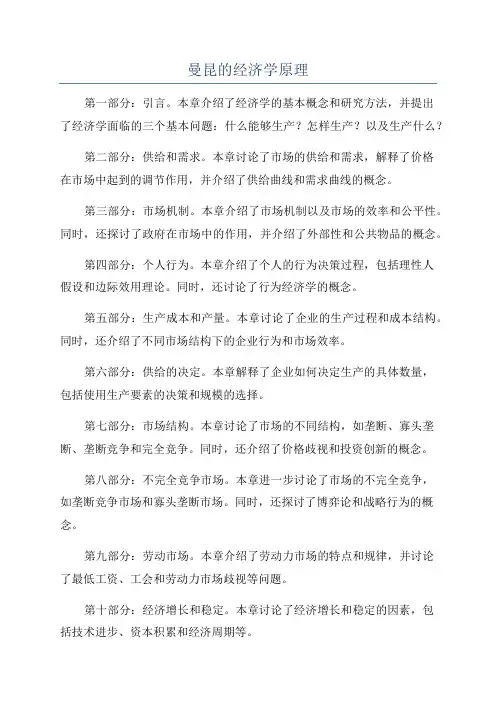
曼昆的经济学原理第一部分:引言。
本章介绍了经济学的基本概念和研究方法,并提出了经济学面临的三个基本问题:什么能够生产?怎样生产?以及生产什么?第二部分:供给和需求。
本章讨论了市场的供给和需求,解释了价格在市场中起到的调节作用,并介绍了供给曲线和需求曲线的概念。
第三部分:市场机制。
本章介绍了市场机制以及市场的效率和公平性。
同时,还探讨了政府在市场中的作用,并介绍了外部性和公共物品的概念。
第四部分:个人行为。
本章介绍了个人的行为决策过程,包括理性人假设和边际效用理论。
同时,还讨论了行为经济学的概念。
第五部分:生产成本和产量。
本章讨论了企业的生产过程和成本结构。
同时,还介绍了不同市场结构下的企业行为和市场效率。
第六部分:供给的决定。
本章解释了企业如何决定生产的具体数量,包括使用生产要素的决策和规模的选择。
第七部分:市场结构。
本章讨论了市场的不同结构,如垄断、寡头垄断、垄断竞争和完全竞争。
同时,还介绍了价格歧视和投资创新的概念。
第八部分:不完全竞争市场。
本章进一步讨论了市场的不完全竞争,如垄断竞争市场和寡头垄断市场。
同时,还探讨了博弈论和战略行为的概念。
第九部分:劳动市场。
本章介绍了劳动力市场的特点和规律,并讨论了最低工资、工会和劳动力市场歧视等问题。
第十部分:经济增长和稳定。
本章讨论了经济增长和稳定的因素,包括技术进步、资本积累和经济周期等。
总而言之,曼昆的经济学原理是一本系统而全面的经济学教材,旨在帮助读者理解和运用经济学原理来分析和解决实际经济问题。
通过该书的学习,读者可以掌握经济学的基本概念,了解市场的运作机制,并能够运用经济学原理来解决现实生活中的经济问题。
无论是对经济学专业的学生,还是对普通读者来说,这本书都是一本很好的入门教材。
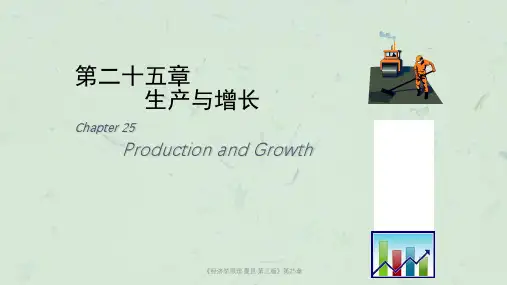
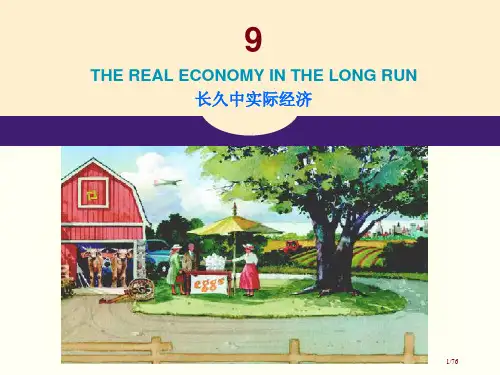
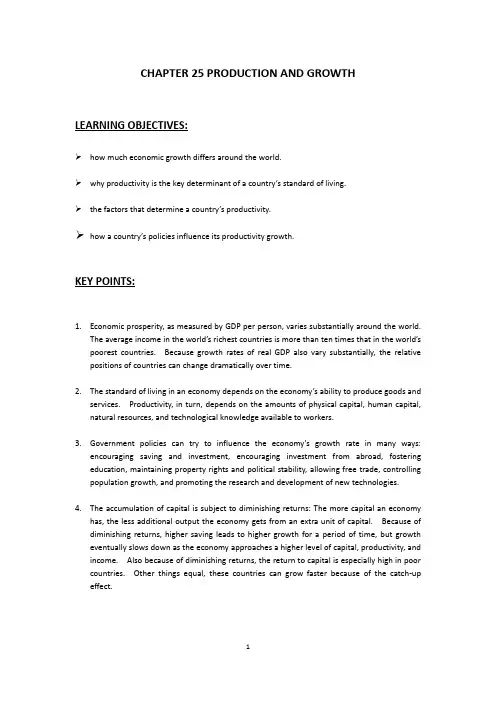
CHAPTER 25 PRODUCTION AND GROWTH LEARNING OBJECTIVES:how much economic growth differs around the world.why productivity is the key determinant of a country’s standard of living.the factors that determine a country’s productivity.how a country’s po licies influence its productivity growth.KEY POINTS:1.Economic prosperity, as measured by GDP per person, varies substantially around the world.The average income in the world’s richest countries is more than ten times that in the world’s poorest countries. Because growth rates of real GDP also vary substantially, the relative positions of countries can change dramatically over time.2.The standard of living in an economy depends on the economy’s ability to produce goods andservices. Productivity, in turn, depends on the amounts of physical capital, human capital, natural resources, and technological knowledge available to workers.ernment policies can try to influence the economy’s growth rate in many ways:encouraging saving and investment, encouraging investment from abroad, fostering education, maintaining property rights and political stability, allowing free trade, controlling population growth, and promoting the research and development of new technologies.4.The accumulation of capital is subject to diminishing returns: The more capital an economyhas, the less additional output the economy gets from an extra unit of capital. Because of diminishing returns, higher saving leads to higher growth for a period of time, but growth eventually slows down as the economy approaches a higher level of capital, productivity, and income. Also because of diminishing returns, the return to capital is especially high in poor countries. Other things equal, these countries can grow faster because of the catch-up effect.OUTLINE:I. Economic Growth around the WorldA. Table 1 shows data on real GDP per person for 13 countries during differentperiods of time.1. The data reveal the fact that living standards vary a great deal betweenthese countries.2. Growth rates are also reported in the table. Japan has had the largestgrowth rate over time, 2.8 percent per year (on average).3. Because of different growth rates, the ranking of countries by incomeper person changes over time.a. In the late 19th century, the United Kingdom was the richestcountry in the world.b. Today, income per person is lower in the United Kingdom thanin the United States and Canada (two former colonies of theUnited Kingdom).II. Productivity: Its Role and DeterminantsA. Why Productivity Is So Important1. Example: Robinson Crusoea. Because he is stranded alone, he must catch his own fish, growhis own vegetables, and make his own clothes.b. His standard of living depends on his ability to produce goodsand services.2. Definition of productivity: the amount of goods and services producedfor each hour of a worker’s time.3. Review of Principle #8: A Country’s Standard of Living Depends on ItsAbility to Produce Goods and Services.B. How Productivity Is Determined1. Physical Capitala. Definition of physical capital: the stock of equipment andstructures that are used to produce goods and services.b. Example: Crusoe will catch more fish if he has more fishingpoles.2. Human Capitala. Definition of human capital: the knowledge and skills thatworkers acquire through education, training, and experience.b. Example: Crusoe will catch more fish if he has been trained inthe best fishing techniques.3. Natural Resourcesa. Definition of natural resources: the inputs into the productionof goods and services that are provided by nature, such asland, rivers, and mineral deposits.b. Example: Crusoe will have better luck catching fish if there is aplentiful supply around his island.4. Technological Knowledgea. Definition of technological knowledge: society’sunderstanding of the best ways to produce goods andservices.b. Example: Crusoe will catch more fish if he has invented a betterfishing lure.C. FYI: The Production Function1. A production function describes the relationship between the quantityof inputs used in production and the quantity of output fromproduction.2. The production function generally is written like this:where Y = output, L = quantity of labor, K = quantity of physical capital,H= quantity of human capital, N= quantity of natural resources, Areflects the available production technology, and F(·) is a function thatshows how inputs are combined to produce output.3. Many production functions have a property called constant returns toscale.a. This property implies that as all inputs are doubled, output willexactly double.b. This implies that the following must be true:where x =2 if inputs are doubled.c. This also means that if we want to examine output per workerwe could set x = 1/L and we would get the following:This shows that output per worker depends on the amount ofphysical capital per worker (K/L), the amount of human capitalper worker (H/L), and the amount of natural resources perworker (N/L).III. Economic Growth and Public PolicyA. The Importance of Saving and Investment1. Because capital is a produced factor of production, a society can changethe amount of capital that it has.2. However, there is an opportunity cost of doing so; if resources are usedto produce capital goods, fewer goods and services are produced forcurrent consumption.3. Figure 1 shows economic growth rates and investment amounts of 15countries for 1960 to 1991.a. Countries that devote a large share of GDP to investment tendto have high growth rates.b. However, from the data given it is difficult to determine causeand effect.B. Diminishing Returns and the Catch-Up Effect1. Definition of diminishing returns: the property whereby the benefitfrom an extra unit of an input declines as the quantity of the inputincreases.a. As the capital stock rises, the extra output produced from anadditional unit of capital will fall.b. Thus, if workers already have a large amount of capital to workwith, giving them an additional unit of capital will not increasetheir productivity by much.c. In the long run, a higher saving rate leads to a higher level ofproductivity and income, but not to higher growth rates inthese variables.2. An important implication of diminishing returns is the Catch-Up Effect.a. Definition of catch-up effect: the property whereby countriesthat start off poor tend to grow more rapidly than countriesthat start off rich.b. When workers have very little capital to begin with, anadditional unit of capital will increase their productivity by agreat deal.c. This helps explain why (referring to Figure 1) South Korea had agrowth rate more than three times larger than the UnitedStates even though both countries devoted a similar share ofGDP to investment.C. Investment from Abroad1. Saving by domestic residents is not the only way for a country to investin new capital.2. Investment in the country by foreigners can also occur.a. Foreign direct investment occurs when a capital investment isowned and operated by a foreign entity.b. Foreign portfolio investment occurs when a capital investmentis financed with foreign money but operated by domesticresidents.3. Some of the benefits of foreign investment flow back to foreign owners.But the economy still experiences an increase in the capital stock, whichleads to higher productivity and higher wages.4. The World Bank is an organization that tries to encourage the flow ofinvestment to poor countries.a. The World Bank obtains funds from developed countries suchas the United States and makes loans to less-developedcountries so that they can invest in roads, sewer systems,schools, and other types of capital.b. The World Bank also offers these countries advice on how bestto use these funds.D. Education1. Investment in human capital also has an opportunity cost.a. When students are in class, they cannot be producing goodsand services for consumption.b. In less-developed countries, this opportunity cost is consideredto be high; as a result, children often drop out of school at ayoung age.2. Because there are positive externalities in education, the effect of lowereducation on the economic growth rate of a country can be large.3. Many poor countrie s also face a “brain drain”—the best educated oftenleave to go to other countries where they can enjoy a higher standard ofliving.E. Health and Nutrition1. Human capital can also be used to describe another type of investmentin people: expenditures that lead to a healthier population.2. Other things being equal, healthier workers are more productive.3. Making the right investments in the health of the population is one wayfor a nation to increase productivity.F. Property Rights and Political Stability1. Protection of property rights and promotion of political stability are twoother important ways that policymakers can improve economic growth.2. There is little incentive to produce products if there is no guarantee thatthey cannot be taken. Contracts must also be enforced.3. Countries with questionable enforcement of property rights or anunstable political climate will also have difficulty in attracting foreign (oreven domestic) investment.G. Free Trade1. Some countries have tried to achieve faster economic growth byavoiding transacting with the rest of the world.2. However, we know that trade allows a country to specialize in what itdoes best and thus consume beyond its production possibilities.3. When a country trades wheat for steel, it is as well off as it would be if ithad developed a new technology for turning wheat into steel.4. The amount a nation trades is determined not only by governmentpolicy but also by geography.a. Countries with good, natural seaports find trade easier thancountries without this resource.b. Many African countries, for example, are landlocked. This maybe one reason why the continent is so poor.H. Research and Development1. The primary reason why living standards have improved over time hasbeen due to large increases in technological knowledge.2. Knowledge can be considered to be a public good.3. The U.S. government promotes the creation of new technologicalinformation by providing research grants and providing tax incentivesfor firms engaged in research.4. The patent system also encourages research by granting an inventor theexclusive right to produce the product for a specified number of years.I. Population Growth1. Stretching Natural Resourcesa. Thomas Malthus (an English minister and early economicthinker) argued that an ever-increasing population meant thatthe world was doomed to live in poverty forever.b. However, he failed to understand that new ideas would bedeveloped to increase the production of food and other goods,including pesticides, fertilizers, mechanized equipment, andnew crop varieties.2. Diluting the Capital Stocka. High population growth reduces GDP per worker because rapidgrowth in the number of workers forces the capital stock to bespread more thinly.b. Countries with a high population growth have large numbers ofschool-age children, placing a burden on the education system.3. Some countries have already instituted measures to reduce populationgrowth rates.4. Policies that foster equal treatment for women should raise economicopportunities for women leading to lower rates of population.5. Promoting Technological Progressa. Some economists have suggested that population growth hasdriven technological progress and economic prosperity.b. In a 1993 journal article, economist Michael Kremer providedevidence that increases in population lead to technologicalprogress.。
第9篇长期中的真实经济第25章生产与增长25.1 复习笔记跨考网独家整理最全经济学考研真题,经济学考研课后习题解析资料库,您可以在这里查阅历年经济学考研真题,经济学考研课后习题,经济学考研参考书等内容,更有跨考考研历年辅导的经济学学哥学姐的经济学考研经验,从前辈中获得的经验对初学者来说是宝贵的财富,这或许能帮你少走弯路,躲开一些陷阱。
以下内容为跨考网独家整理,如您还需更多考研资料,可选择经济学一对一在线咨询进行咨询。
1.生产率(1)定义生产率指用以衡量每单位投入要素的产出量的指标。
如一个工人单位小时工作所生产的物品与劳务的数量。
(2)生产率的决定因素①人均物质资本。
物质资本是指用于生产物品与劳务的设备与建筑物存量。
②人均人力资本。
人力资本是指通过对人的教育、培训、实践经验、迁移、保健等方面的投资而获得的知识和技能的积累。
③人均自然资源。
自然资源是指自然界提供的生产投入,如土地、河流和矿藏。
自然资源有两种形式:可再生的与不可再生的。
④技术知识。
技术知识指的是自适应的、可在公众间传递的信息与技巧。
2.经济增长和公共政策(1)经济增长的含义和源泉在宏观经济学中,经济增长通常被定义为产量的增加。
具体理解有两层含义:①经济增长指一个经济体所生产的物质产品和劳务在一个相当长时期内的持续增长,即经济总产量的增长;②经济增长是按人口平均计算的实际产出的持续增长,即人均产量的增长。
经济增长的源泉最主要的因素是:劳动数量增加和质量提高(即人力资本的增长)、资本存量的增加和技术进步(是广义概念,包括采用新技术、新产品、先进管理手段以及资源配置的高效率等)。
(2)储蓄和投资①储蓄是指个人可支配收入中用于消费支出后所剩余的部分。
储蓄是西方宏观经济学中的一个重要概念,也是凯恩斯收入与就业理论的重要概念之一。
但是,储蓄是一个不容易确定的概念,无论从它的来源还是作用方面看,均没有准确的数量限制。
储蓄可能是正数,也可能是负数。
当可支配收入大于最终的消费支出时,储蓄值为正数;反之,则为负数。